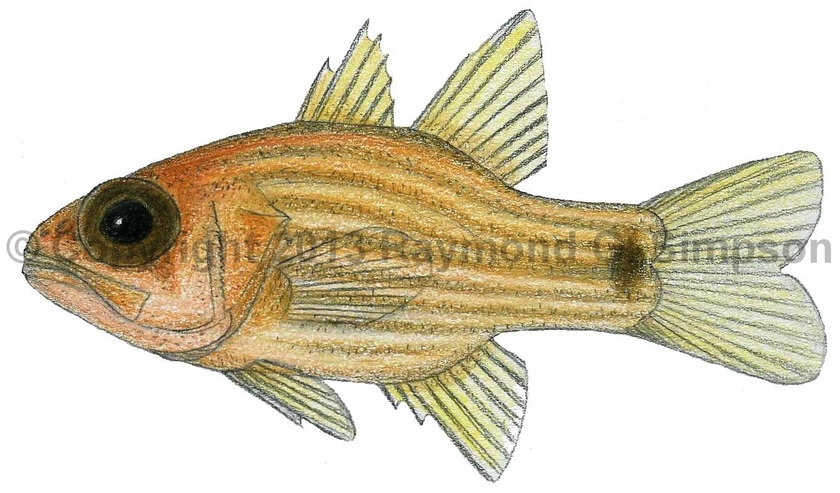
Common Name
Striped Cardinalfish
Year Described
Gilbert & Tyler, 1997
Identification
Dorsal Fin: VI, I-9
Anal Fin: II, 8
Pelvic Fin: I, 5
Pectoral Fin: 12
Gill Rakers: 4-5 on upper, 12-14 on lower
Vertebrae: 10 precaudal, 14 caudal
A small fish with a fairly robust, stout, and moderately compressed body. Eye is large and the snout short. Interorbital narrow (7.2-8.1% SL). Mouth is fairly large and oblique, with the lower jaw slightly protruding. Both jaws, palatine, and vomer with narrow bands of villiform teeth (no canines). Preopercular edge with a finely serrate margin. Preopercular flap does not extend past the preopercular rear margin. There are two dorsal fins. The caudal fin is bluntly emarginate. Body scales ctenoid. Predorsal scales 3-4. Scales around the caudal peduncle 16.
Color
Body reddish, orange, to pale salmon with seven conspicuous brownish stripes on the body from the gill edge to the caudal peduncle. The caudal peduncle has a diffuse, round brown blotch. Scattered brown melanophores on head. The eye is dark red. The fins are translucent pale yellow.
Size
Maximum size to 36mm TL.
Habitat
Shallow coastal waters under 15m. Found in a variety of habitats including rocky reefs, crevices, around anemones, in and around sponges, and in seagrass beds.
Range
Scattered records from Belize, Jamaica, Colombia, and Panama.
References
Baldwin, C. C., Brito, B. J., Smith, D. G., Weigt, L. A. and Escobar-Briones, E. 2011. Identification of early life-history stages of Caribbean Apogon (Perciformes: Apogonidae) through DNA Barcoding. Zootaxa, 3133: 1-36.
Gilbert, C.R. and J.C. Tyler, 1997. Apogon robbyi, a new cardinalfish (Perciformes: Apogonidae) from the Caribbean Sea. Bull. Mar. Sci. 60(3):764-781.
Gon, O. 2002. Apogonidae (pp 1386-1391). In: Carpenter. 2002. The living marine resources of the Western Central Atlantic. Vol. 3: Bony fishes part 2 (Opistognathidae to Molidae), sea turtles and sea mammals. FAO Species Identification Guides for Fisheries Purposes. American Society of Ichthyologists and Herpetologists Special Publication No. 5.
Other Notes
Closely related to Apogon mosavi and A. quadrisquamatus. Best distinguished from these by color pattern and interorbital width.